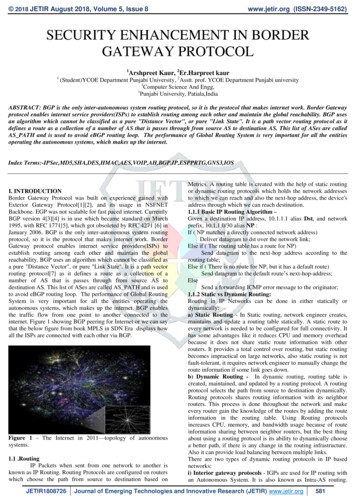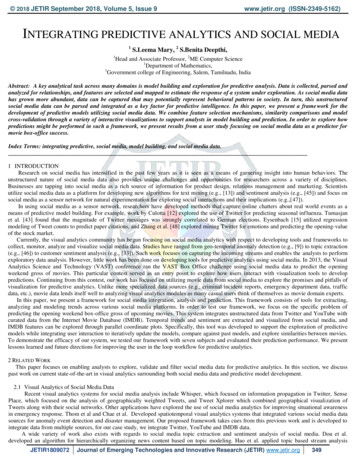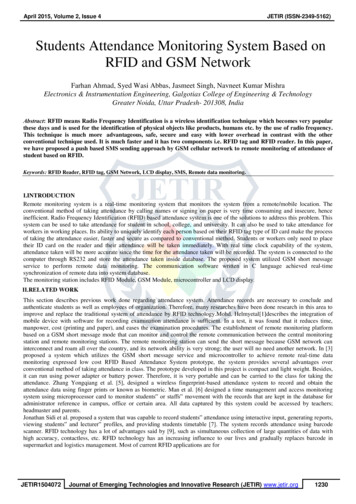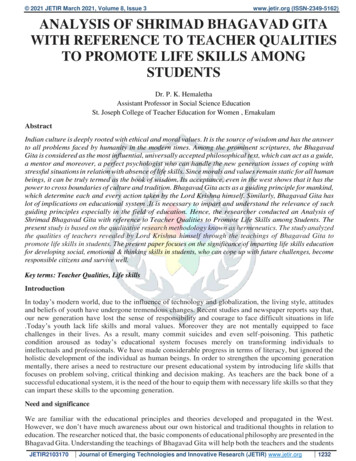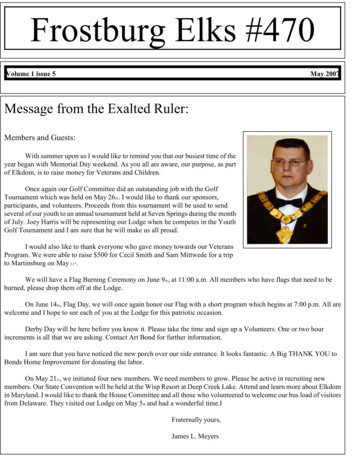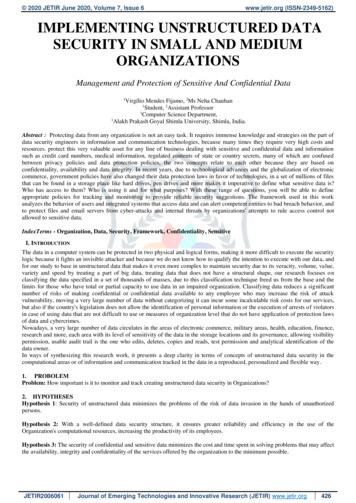
Transcription
2020 JETIR June 2020, Volume 7, Issue 6www.jetir.org (ISSN-2349-5162)IMPLEMENTING UNSTRUCTURED DATASECURITY IN SMALL AND MEDIUMORGANIZATIONSManagement and Protection of Sensitive And Confidential Data1Virgílio Mendes Fijamo, 2Ms Neha Chauhan1Student, 2Assistant Professor1Computer Science Department,1Alakh Prakash Goyal Shimla University, Shimla, India.Abstract : Protecting data from any organization is not an easy task. It requires immense knowledge and strategies on the part ofdata security engineers in information and communication technologies, because many times they require very high costs andresources. protect this very valuable asset for any line of business dealing with sensitive and confidential data and informationsuch as credit card numbers, medical information, regulated contents of state or country secrets, many of which are confusedbetween privacy policies and data protection policies, the two concepts relate to each other because they are based onconfidentiality, availability and data integrity. In recent years, due to technological advances and the globalization of electroniccommerce, government policies have also changed their data protection laws in favor of technologies, in a set of millions of filesthat can be found in a storage place like hard drives, pen drives and more makes it imperative to define what sensitive data is?Who has access to them? Who is using it and for what purposes? With these range of questions, you will be able to defineappropriate policies for tracking and monitoring to provide reliable security suggestions. The framework used in this workanalyzes the behavior of users and integrated systems that access data and can alert competent entities to bad breach behavior, andto protect files and email servers from cyber-attacks and internal threats by organizations' attempts to rule access control notallowed to sensitive data.IndexTerms - Organization, Data, Security, Framework, Confidentiality, SensitiveI. INTRODUCTIONThe data in a computer system can be protected in two physical and logical forms, making it more difficult to execute the securitylogic because it fights an invisible attacker and because we do not know how to qualify the intention to execute with our data, andfor our study to base in unstructured data that makes it even more complex to maintain security due to its veracity, volume, value,variety and speed by treating a part of big data, treating data that does not have a structural shape, our research focuses onclassifying the data specified in a set of thousands of masses, due to this classification technique freed us from the base and thelimits for those who have total or partial capacity to use data in an impaired organization. Classifying data reduces a significantnumber of risks of making confidential or confidential data available to any employee who may increase the risk of attackvulnerability, moving a very large number of data without categorizing it can incur some incalculable risk costs for our services,but also if the country's legislation does not allow the identification of personal information or the execution of arrests of violatorsin case of using data that are not difficult to use or measures of organization level that do not have application of protection lawsof data and cybercrimes.Nowadays, a very large number of data circulates in the areas of electronic commerce, military areas, health, education, finance,research and more, each area with its level of sensitivity of the data in the storage locations and its governance, allowing visibilitypermission, usable audit trail is the one who edits, deletes, copies and reads, test permission and analytical identification of thedata owner.In ways of synthesizing this research work, it presents a deep clarity in terms of concepts of unstructured data security in thecomputational areas or of information and communication tracked in the data in a reproduced, personalized and flexible way.1. PROBOLEMProblem: How important is it to monitor and track creating unstructured data security in Organizations?2. HYPOTHESESHypothesis 1: Security of unstructured data minimizes the problems of the risk of data invasion in the hands of unauthorizedpersons.Hypothesis 2: With a well-defined data security structure, it ensures greater reliability and efficiency in the use of theOrganization's computational resources, increasing the productivity of its employees.Hypothesis 3: The security of confidential and sensitive data minimizes the cost and time spent in solving problems that may affectthe availability, integrity and confidentiality of the services offered by the organization to the minimum possible.JETIR2006061Journal of Emerging Technologies and Innovative Research (JETIR) www.jetir.org426
2020 JETIR June 2020, Volume 7, Issue 6www.jetir.org (ISSN-2349-5162)3. OBJECTIVES3.1. GENERAL OBJECTIVEAnalyze the importance of creating security of sensitive and confidential data in a set of unstructured data in state institutions inMozambique.3.2. SPECIFIC OBJECTIVESFind out how much the security of unstructured data minimizes problems in an organization, making it more stable and reliable,causing the minimization of costs and optimization of the productivity of the services provided.Analyze the misuse of sensitive and confidential data in organizations to implement security mechanisms.Study the use of the tool Varonis IDU Classification Framework for analyzing sensitive data in files or directories in any storagelocation, assessing the reliability and efficiency in detecting or verifying sensitive data sought by malicious attackers.4. CLASSIFICATION OF DATAData classification is the process of categorizing and classifying data according to its variety, veracity and type or any otherdifferent class. The classification of data allows analysis and separation of sensitive and confidential data according to the specifictype of business of the organization, since organizations are created to provide products and services [7] and whose organizationcan be of an economic or social.Organizations of an economic nature are those that have a specific company character and seek a profitable purpose, where intheir execution they take risks, pay legislative taxes according to the country and are directed by a CEO who is the financialdirector who directs by a philosophy of business and another of a social nature aimed at common actions of non-profit publicutility more distant in humanitarian aids that can operate in any territory of a country that have a diplomatic effect in the socialenvironment and supports. For our study, we will focus on organizations of an economic nature due to the risks that they mayhave in the invasion of confidential data.To classify data, one must have a purpose and purpose for our case study is to maintain the security of sensitive data byminimizing the operating costs in its implementation, mainly in the process of managing organizational data.What is unstructured DataAccording to the classification of the data, it can be structured, semi-structured and unstructured, for normally unstructured data,data that does not come from a pre-defined model, that is not easily tabulated, such as information found in a file text - but thatcan bring data about dates, accounts, different numbers, etc. and even audio and video files. In short it is all the data contained inthe files used in the user's day-to-day activities. The other authors define unstructured data, which is data that does not necessarilyhave a format or sequence, does not follow rules and is not predictable. This type of data is currently receiving a lot of attentiondue mainly to the proliferation of mobile devices responsible for creating a wide variety of data. However, there are other datasources such as machine sensors, smart devices, collaboration technologies and social networks. These data are not related butdiversified data. Some examples of this type of data are: Texts, videos, images, etc. [8]. The challenge in managing unstructureddata is much more complex. The flow of information can be considered free and it is enough for a malicious user or a lessattentive employee to copy the file for all security barriers to be ignored. Thus, working with a platform that indicates wheresensitive data is hosted and who is accessing it is mandatory. You need to detect unauthorized behavior, the misuse of privilegesor file escalation, corporate email and shared services, such as Active Directory. This data visibility must be presented to IT andsecurity teams via detailed reports and records that contribute to meeting security and privacy compliance standards.Structured DataThese types of data contain an organization that is very easy to be recopied because it represents an organizational shape andstructure such as rows and columns that identify different points of information, this type of data is easier to query usingcommands like SQL, more like this data found in structured databases.Table 1 - Differences between structured, semi-structured and unstructured dataStructured DataPredefined structureRegular structureIndependent data structureSemi-Structured DataThere is not always a schemeIrregular structureStructure embedded in the dataReduced structureExtensive structure (particular ineach data since each one can have itsown organization)Very evolutionary, the structure canchange very oftenThere is no associated data schemaLittle evolutionary and very rigidHas closed schema and integrityconstraintsClear distinction of the data structureThe distinction betweenstructure is not cleardataUnstructured DataThere is no schemeIrregular structureThe structure is dependent on theSource of dataExtensive structure depends a lot onthe data typeVery evolutionary, the structurechanges quite frequentlyThere is no associated data schemaIt is not possible to distinguishbetween data structuresUnstructured Data ManagementData is everywhere in computer systems today and is an essential ingredient for any organization's business strategy. As the datais not created in the same way others may have come from the Internet of Things (IoT),[18] [23] its management is varied.JETIR2006061Journal of Emerging Technologies and Innovative Research (JETIR) www.jetir.org427
2020 JETIR June 2020, Volume 7, Issue 6www.jetir.org (ISSN-2349-5162)However, access to this data must always be monitored, tracked and protected. As organizations change their way of working to amore collaborative and modern modality, the number of files or folders grows exponentially, along with access control policies,and this content is usually stored in the cloud or on the local computer system due Internet costs, without proper protection andcare to take on your vulnerability. Also, migration to the cloud presents an additional risk, after all, any consultation, alteration orexclusion needs to be done over the internet where most of the malicious people are to satiate their appetites by invading thirdparty data. Despite the danger, this access is extremely important for the modernization of organizations' businesses managingthese files used to be reactively easy in an environment with structured systems and applications. Today, with the proliferation ofapplications and mobile devices such as smart car, smart house, smart phone and others, user generated data includes a range offiles that can include documents, reports, presentations, spreadsheets, PDFs, photos, basically archived from individually.Security ResponsibilityIn order to maintain data security, all stakeholders in the organization are involved, employees in internal and external servicesfrom all areas involved in the organization, especially key sectors such as human resources, marketing, the IT department aremore vulnerable due to their data sensitivity, only with these responsibilities will the security mechanism be able to functionproperly, taking into account that the biggest access door to internal information or data of a certain organization, there has been afacilitation of someone who knows all corners of the organization. However, in our analysis of what has happened in recent years,we can see that the lines between privacy and security are becoming more and more parallel; this does not mean that theseconcepts are the same, but that they are intricate.Security consists of implementing the appropriate technical controls, such as multifactorial authentication, strong encryption andregistration to protect data privacy, on the other hand, comes down to how this data is stored, accessed, and transmitted over thenetwork or locally, its confidentiality applies.Data Security ImpactsThe big impact is on data leakage, which is a real and growing problem nowadays due to the huge increase and flow of digitalinformation every month, news about confidential or confidential data leaks becomes public. These are the known cases, that is,that have a visible impact but many more similar incidents occur daily without being disclosed to the public, thus keeping theorganizations secret so as not to create discrediting of the services of the organizations, and the vast majority of leakages. data isaccidental where employees with little knowledge in the areas of information and communication technologies end up exposingthe security of the organization, it is not only the result of intentional and harmful actions that prove many of the adversaries’business in the business due to economic or malicious interactions, they entice employees in money or promises of highleadership positions in your organization, making it easier for the adversary’s data, employees less committed to the businessenter the scheme. Unintentional data loss is perhaps the most dangerous, because those affected are not necessarily aware of orable to act on the problem due to the lack of financial conditions for the investigation of criminals. The loss of data can representa very high cost for organizations; this failure generates direct and indirect costs to intellectual property or industrial informationitself, in addition to the cost to deal with the consequences of the loss. Indirect losses include loss of credibility, erosion ofcompetitive advantage and regulatory breaches in the market.Varonis IDU Classification FrameworkIt is a powerful tracking and confirmation platform that can simulate access control changes for specific users of files,computational resources such as data, email servers etc. One of the mannequin features is to be able to alert you in the event ofattempts to violate rules to allow access to data in storage locations as external and internal hard drives.And manly can perform dependency checks and allow multithreaded work, scheduling tasks and reverting your changes in a fewwords. Manly IDU is a framework [9] for classifying data according to your level of sensitivity is sensitive and confidential dataof any organization in the case of our study we deal with small and medium organizations. We can illustrate in the figure belowthe access control mechanisms in a SandBox.JETIR2006061Journal of Emerging Technologies and Innovative Research (JETIR) www.jetir.org428
2020 JETIR June 2020, Volume 7, Issue 6www.jetir.org (ISSN-2349-5162)Figure.1 Confirmation Mechanism of accesAbbreviations and AcronymsSQL – Structured Query LanguageXML – Extensible Markup LanguageCEO – Chief Executive OfficerIT – Information TechnologyIoT – Internet of ThingsIS – Information SecurityCIA – Confidentiality, Integrity, AvailabilityAI – Artificial IntelligencePDFs – Portable Document FormatBI – Business IntelligentNoSQL– Not Only Structured Query LanguageScreen to privilegesA screen to eliminate global access for Varonis users, whose elimination can be scheduled or can have an immediate effect,discovering and revising permissions for critical folders in a Varonis IDU Classification Framework in a graphical environment isvery easy where any users with administrative privileges can do it without having a strong knowledge of information andcommunication technologies, as we can illustrate the figure below in removing user privileges Erin Hannon.Figure 2 Screen to eliminate global accessJETIR2006061Journal of Emerging Technologies and Innovative Research (JETIR) www.jetir.org429
2020 JETIR June 2020, Volume 7, Issue 6www.jetir.org (ISSN-2349-5162)II. RESEARCH METHODOLOGYThis research aims to create a knowledge in the small and medium Mozambican organizations to invest in the security of theirdata using Varonis IDU Classification Framework which is very powerful in maintaining the classification and tracking ofunstructured data of the sensitive and confidential type in the storage hard drives or on servers and files, the main seven activitiesof which will be illustrated in the figure below of how this Framework works, but the study will focus more on contentclassification and support giving an alert in case of violation of access to privacy.Figure 2 Data Protection Project StepsAccording to [4] proposed XML data filtering mechanisms of a model not centralized on the internet and another in its similarityto the type of meta data, since this data model that the author made the filtering process is non-data structured, filtering a set ofXML model documents involves cost and effect compared to the ideal number of data that will be useful for our purpose.Filtering a large volume of data requires a lot of knowledge in its handling until the final stage of processing in addition to veryhigh computational resources on hardware.This process of filtering content is very time consuming compared to the IDU framework of our study which is very fast andsecure and with a variety of data in a graphical way.3.1Population and SampleA set of three (3) organizations was selected for direct observation for the use of monitoring and control of sensitive datain a universe of six (6) organizations. The criterion for choosing these organizations has to do with the diversity of the type ofbusiness, since it is about commerce, education and research that on average 75% of organizations are located in that country.What leads us to take a very small sample is due to the physical location of the province with 102 Km 2, and with little study ondata security and its protection. The study composed by almost all government organizations, which still limited us a lot inchallenging the implementation of security which involves additional costs for its implementation considering a very critical year2020 where these organizations depend very fundamentally on the budget of the central government of the country.3.2 Data and Sources of DataFor this study, primary data are collected in northern Mozambique in three categories, including the National forEconomic Activities, the Ministry of Science and Technology and Higher and Technical Professional Education and the CaboDelgado Provincial Directorate of Education and Human Development, then done between February and March 2020. And itdetected an almost inadequate model of data storage in the stored storage locations subject to vulnerability.3.3 Theoretical frameworkImplementation of the structural model of deep information security structure [10], for security meters that meet theoperational operations characteristic of individuals, and the basic principle for maintaining security, which is integrity,confidentiality and availability (CIA), delivered its limitation in comparison with the deep structural model that analyzes locks,padlocks, keys, passwords and firewalls for this purpose, it is necessary to implement a deep security structure due to itsconceptual clarity, in keeping the personalization and flexibility in solving security problems.In the analyzes made for this type of model, its effectiveness in tracking faults that may arise in a system that does not help tocreate information and communication security is shown.Information security is provided by many researchers who meet the needs of risk analysts in early childhood education activities,followed by [11] characterized as information security approaches in three checklist categories, risk analysis and formed modelsand more later other categories added to include behavioral issues of the users of the site due to the advancement of informationand communication technologies in the implementation of machines related to Artificial Intelligence (AI).JETIR2006061Journal of Emerging Technologies and Innovative Research (JETIR) www.jetir.org430
2020 JETIR June 2020, Volume 7, Issue 6www.jetir.org (ISSN-2349-5162)No scheme by Jiafu Jiang, Linyu Tang, no. all [14] the fog server is responsible for processing requests and resource allocationsand the cloud audit center is responsible for auditing the performance of the new servers and fog nodes. The big challenge Basedon the proposed security framework, our proposed scheme can resist or attack a single malicious node and attack fog servers andcomputing devices. In addition, experiments show that the scheme is efficient.NoSQL and data repositories NewSQ[15] presents alternatives that can handle a large volume of data. Because of the largenumber and diversity of existing NoSQL and NewSQL solutions, it is difficult to understand the domain and even morechallenging to choose an applicable solution for a specific task. Therefore, this article analyzes NoSQL and NewSQL solutions inorder to [16]: Provide perspective in the field; Provide guidance for professionals and researchers to choose the appropriate data storage and Identify challenges and opportunities in the field.Specifically, how more important solutions are compared with a focus on data models, queries, scaling and security-relatedfeatures. Features that direct the ability to request read and write requests or dimensioning or storage of investigated data, inparticular partitioning, replication, consistency and concurrency control.In addition [17], use cases and scenarios in which NoSQL and NewSQL data repositories were used to suit various solutions fordifferent sets of applications examined are discussed. Consequently, this study has specific challenges in the field, including thedifference and inconsistency of terminologies, the restrictions, the usage restrictions, the spatial differences and the comparisonand the lack of standardized query languages.III. RESULTS AND DISCUSSIONVaronis released the results of data collection carried out over a year in risk assessments conducted for potential customers in alimited number of its systems. The 2018 results show an impressive level of exposure for corporate files, including an average of9.9 million files per assessment that were accessible to any employee in the organization.Varonis Dat Advantage offers full visibility of who is authorized and in fact accesses unstructured files and data[22]. The VaronisData Classification Framework identifies regulated and sensitive information, such as credit card numbers and medical patientdata, and maps exposures in the file system. Even while remediation projects are being carried out, Varonis DatAlert can detectand stop internal threats, unauthorized privilege escalations and ransomware attacks, such as Cryptolocker.From the insights generated from the dozens of risk assessments conducted during the year in small and medium-sizedorganizations, Varonis found that, on average, each organization had: 35.3 million files stored in 4 million folders - that is, about 8.8 files per folder; 1.1 million folders, or an average of 28% of all folders, open to all network users; 9.9 million files accessible to all employees of the organization, regardless of their position; 2.8 million folders, or 70% of all folders, containing obsolete data - untouched in the last six months; 25 thousand user accounts, of which 7,700 of them (or 31%) have not logged in in the last 60 days, suggesting that they areformer employees, people who have changed positions, or consultants and employees who no longer provide services to theorganization.Leaving a file open for all users on the network is a common convenience when setting permissions. This massive access alsomakes it much easier for hackers to steal corporate data.During the assessments, Varonis found some negative points that stood out: In one of the organizations, each employee had access to 82% of the 6.1 million folders; Another organization had more than 2 million files containing sensitive data (credit cards, social security and accountnumbers) with free access for everyone in the company; 50% of the folders of another company were allowed access for everyone, and more than 14 thousand files in these folderswere sensitive; A single organization had more than 146,000 inactive users - accounts that had not been accessed in the past 60 days. Thenumber is three times the average number of total employees in the Fortune 500 organization.IV.ACKNOWLEDGMENTTo my teachers who shared knowledge throughout the academic day. In a special way to Mr. Keshav Kishore, who is largelyresponsible for our learning in the programming language; Our Advisor Ms. Neha Chauhan, for her assistance in the constructionof this work, her attention and disposition, regardless of the day and time, even from a distance, was always present, especially incorrections; To our new friendships conceived at the University. May they last as long as they were intense; finally, our mostsincere thanks to my children, Aymane, Elizabete, Ganissa and family, for their strength and moral support.“The world is not threatened by bad people, but by those who allow the evil”. Albert EinsteinREFERENCES[1] Study Regarding Data Security and Safety in Small and Medium-Sized Companies[2] Rodrigo Werlinger, Kirstie Hawkey, Konstantin Beznosov.Human, Organizational and Technological Challenges ofImplementing IT Security in Organizations[3] Yang Chen, Wenmin Li, Fei Gao, Wei Yin. December 2019. Kaitai Liang, Efficient Attribute-Based Data Sharing Schemewith Hidden Access Structures. The Computer Journal, Volume 62, Issue 12, Pages 1748–1760[4] Georgia Koloniari, Evaggelia Pitoura.2004. Filters for XML-based Service Discovery in Pervasive Computing. The ComputerJournal, Volume 47, Issue 4, Pages 461–474[5] Manoj Thomas, Gurpreet Dhillon. October 2012.Interpreting Deep Structures of Information Systems Security. The ComputerJournal, Volume 55, Issue 10, Pages 1148–1156JETIR2006061Journal of Emerging Technologies and Innovative Research (JETIR) www.jetir.org431
2020 JETIR June 2020, Volume 7, Issue 6www.jetir.org (ISSN-2349-5162)[6] Oluyinka. I. Omotosho. September- 2019.A Review on Cloud Computing Security. International Journal of Computer Scienceand Mobile Computing, Vol.8 Issue.9,pg. 245-257[7] MARCONDES, José. April 25, 2019.Organization - Concepts, characteristics and types of organizations.[8] Guolinag, L., Beng, C. O., Jianhua, F., Jianyoung, W., & Lizhu, Z. 2008. EASE: an effective 3-in-1 keyword search methodfor unstructured, semi-structured and structured data. SIGMOD '08 Proceedings of the 2008 ACM SIGMOD, pp. 903-914[9] https://www.varonis.com/customers/[10] Manoj Thomas and Gurpreet Dhillon.2011.Interpreting Deep Structures of Information Systems Security, Published byOxford University Press on behalf of The British Computer Society[11] Dhillon, G. and Backhouse, J. 2001 Current directions in IS security research: towards socio-organizational perspectives. Inf.Syst. J., 11,pages 127–153.[12] Bishop, M. 2003Computer Security. Art and science. Addison-Wesley, Boston, MA.[13] Bonomi, F., Milito, R., Zhu, J. and Addepalli, S. 2012. Fog Computing and Its Role in the Internet of Things. In Proc.of the First Edition of the MCC Workshop on Mobile Cloud Computing, Helsinki, Finland, August 17, pp. 13–16[14] Jiafu Jiang, Linyu Tang, KeGu and WeiJia Jia.2019.Secure Computing Resource Allocation Framework For Open FogComputing.[15] Tudorica BG, Bucur C .2011. A comparison between several NoSQL databases with comments and notes. 2011 10thInternational Conference RoEduNet. IEEE:1–5[16] Sadalage PJ, Fowler M .2013. NoSQL distilled: a brief guide to the emerging world of polyglot persistence. AddisonWesley, Upper Saddle River, NJ[17] Aslett M.2011. How will the database incumbents respond to NoSQL and NewSQL.[18] Shah-Mansouri, H. and Wong, V. W. 2018.Hierarchical fogcloud computing for IoT systems: a computation offloadinggame. IEEE Internet Things J., 5, 3246–3257.[19] Ohlhorst FJ.2013.Big Data Analytics:Turning Big Data into Big Money. John Wiley & Sons, Inc, Hoboken, New JerseyUSA[20] Dorothy E. Denning and Peter J. Denning,1979.Data Security, Computing Surveys, Vpl.II, No. 3[21] Alireza Tamjidyamcholo and Rawaa Dawoud Al-Dabbagh.2012.Genetic Algorithm Approach for Risk Reduction ofInformation Security, International Journal of Cyber-Security and Digital Forensics (IJCSDF) 1(1): 59-66[22] Stamp, Mark . 2006.”Information security: principles and practice,” Published by JohnWiley and Sons, Inc., Hoboken, NewJersey, Published simultaneously in Canada[23] Yousefpour, A., Ishigaki, G., Gour, R. and Jue, J. P. 2018. On reducing IoT service delay via fog offloading. IEEE InternetThings J., 5, 998[24] MYERS, Molinari, L.2008. “Testes Funcionais de Software”. Ed. Visual Books. Florianópolis[25] Alotaibi, A., Barnawi, A. and Buhari, M.2017. Attribute-based secure data sharing with efficient revocation in fogcomputing. J. Inform. Secur., 8, 203–222.JETIR2006061Journal of Emerging Technologies and Innovative Research (JETIR) www.jetir.org432
IMPLEMENTING UNSTRUCTURED DATA SECURITY IN SMALL AND MEDIUM . each area with its level of sensitivity of the data in the storage locations and its governance, allowing visibility permission, usable audit trail is the one who edits, deletes, copies and reads, test permission and analytical identification of the data owner. In ways of synthesizing this research work, it presents a deep clarity .
